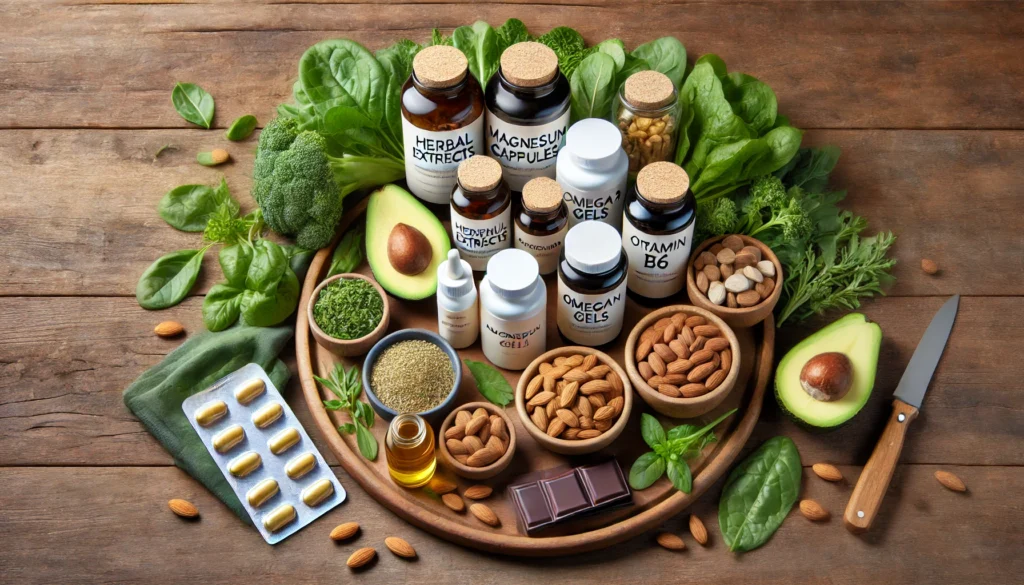Menstrual pain is primarily caused by uterine contractions that occur when the uterus sheds its lining. These contractions are driven by hormone-like substances called prostaglandins. Higher levels of prostaglandins are associated with more severe menstrual cramps. Understanding the biological mechanisms behind menstrual pain can guide us in identifying effective nutritional interventions.
You may also like: Essential Oils for Emotional Well-Being
The Role of Prostaglandins
Prostaglandins are lipid compounds that have diverse hormone-like effects in the body, and they play a pivotal role in the menstrual cycle. They help regulate the contraction and relaxation of the uterine muscles. High levels of prostaglandins can lead to more intense contractions, resulting in severe cramps. Reducing prostaglandin levels through dietary interventions may help alleviate menstrual pain.
Uterine Contractions Explained
During menstruation, the uterus contracts to help expel its lining, which can lead to pain. These contractions are similar to mild labor pains and are a natural part of the menstrual cycle. However, when they are too strong, they can cause significant discomfort. Nutrients that influence muscle relaxation can be particularly beneficial in reducing these contractions.
Hormonal Influence on Pain
Hormones, including estrogen and progesterone, also play a role in the severity of menstrual pain. Imbalances or fluctuations in these hormones can exacerbate symptoms. Nutritional strategies that support hormonal balance may offer additional relief from menstrual discomfort. Exploring the interaction between diet and hormone levels can provide new insights into managing menstrual pain naturally.

Key Vitamins and Minerals for Menstrual Pain Relief
Vitamin B1 (Thiamine)
Vitamin B1, or thiamine, plays a crucial role in energy production and nerve function. Studies suggest that thiamine supplementation can significantly reduce the severity and duration of menstrual cramps. Thiamine is believed to work by enhancing blood flow and reducing muscle tension, thereby alleviating pain.
Mechanism of Action
Thiamine aids in the conversion of carbohydrates into energy, which is vital for muscle relaxation. By supporting the nervous system and muscle function, it can help reduce the frequency and intensity of cramps. Its role in energy production is crucial for maintaining overall cellular function during menstruation.
Clinical Evidence
Research has shown that women who take thiamine supplements report fewer cramps and less severe pain. These findings suggest that thiamine may be a valuable addition to the management of menstrual pain. Studies continue to explore the optimal dosage and duration of supplementation for maximum benefit.
Dietary Sources
Thiamine is naturally present in foods such as whole grains, nuts, seeds, and pork. Incorporating these into daily meals can help maintain adequate levels of this vital nutrient. Ensuring a balanced diet rich in thiamine may offer preventive benefits for menstrual discomfort.
Vitamin B6 (Pyridoxine)
Vitamin B6 is known for its role in neurotransmitter synthesis, which affects mood and pain perception. Research indicates that vitamin B6 can alleviate premenstrual syndrome (PMS) symptoms, including mood swings and irritability, which often accompany menstrual pain. Moreover, B6 may help regulate serotonin levels, contributing to overall pain reduction.
Influence on Neurotransmitters
Vitamin B6 is essential for the production of neurotransmitters such as serotonin and dopamine. These chemicals play a crucial role in mood regulation and pain perception. By supporting neurotransmitter synthesis, B6 can help stabilize mood and reduce the perception of pain during menstruation.
Impact on PMS Symptoms
PMS symptoms, including irritability and mood swings, can exacerbate menstrual pain. Vitamin B6 has been shown to alleviate these symptoms, making menstrual cycles more manageable. Its role in hormone regulation is also thought to contribute to its effectiveness in reducing menstrual discomfort.
Natural Sources of B6
Foods rich in vitamin B6 include poultry, fish, starchy vegetables, and bananas. Incorporating these foods into the diet can help ensure adequate intake. A diet balanced with B6-rich foods may provide a natural way to mitigate menstrual symptoms.
Vitamin E
Vitamin E, a potent antioxidant, has been studied for its effects on menstrual pain. It is thought to reduce oxidative stress and inflammation, both of which play a role in dysmenorrhea. Some studies have shown that taking vitamin E supplements can decrease the intensity of menstrual cramps and reduce the need for pain medication.
Antioxidant Properties
As an antioxidant, vitamin E helps combat oxidative stress, which can exacerbate inflammation and pain. By neutralizing free radicals, it may reduce the inflammatory response associated with menstrual cramps. This antioxidant action is crucial for maintaining cellular health and reducing discomfort.
Research Findings
Clinical studies suggest that vitamin E supplementation can reduce menstrual pain and the need for analgesics. These findings highlight the potential of vitamin E as a natural alternative to conventional pain relief methods. Further research is needed to determine optimal dosing and long-term effects.
Sources of Vitamin E
Vitamin E can be found in nuts, seeds, and green leafy vegetables. Including these foods in your diet can help maintain healthy vitamin E levels. A diet rich in vitamin E may provide protective benefits against menstrual pain.
Magnesium
Magnesium is a mineral known for its muscle relaxant properties. It can help ease uterine contractions, thereby reducing menstrual cramps. Furthermore, magnesium supports serotonin production, potentially improving mood and reducing the perception of pain. Women with low magnesium levels may experience more intense menstrual cramps, highlighting the importance of adequate magnesium intake.
Muscle Relaxation Benefits
Magnesium plays a crucial role in muscle function and relaxation. By helping to relax the uterine muscles, it can significantly reduce menstrual cramp severity. Its calming effect on muscles makes it a valuable nutrient for managing menstrual pain.
Mood and Magnesium
In addition to its physical effects, magnesium influences mood by supporting serotonin production. This dual action can help alleviate both the physical and emotional symptoms of menstruation. Ensuring adequate magnesium intake may therefore support overall well-being during the menstrual cycle.
Dietary Sources of Magnesium
Magnesium-rich foods include dark chocolate, avocados, nuts, and legumes. A diet inclusive of these foods can help maintain magnesium balance. Regular consumption of magnesium-rich foods may contribute to long-term relief from menstrual discomfort.
Omega-3 Fatty Acids
Omega-3 fatty acids, found in fish oil and certain plant oils, have anti-inflammatory properties that can help reduce menstrual pain. Studies suggest that women who consume higher amounts of omega-3s report less severe menstrual cramps. Omega-3s are also believed to modulate prostaglandin production, directly addressing one of the primary causes of dysmenorrhea.
Anti-inflammatory Effects
Omega-3s are known for their ability to reduce inflammation throughout the body. By decreasing the inflammatory response, they may help alleviate menstrual cramps. Their role in modulating inflammation is key to their effectiveness in pain management.
Modulation of Prostaglandins
These fatty acids also influence prostaglandin production, potentially reducing the severity of uterine contractions. By modulating these compounds, omega-3s can directly impact one of the root causes of menstrual pain. Incorporating omega-3s into the diet can thus offer targeted relief.
Natural Sources
Omega-3s are abundant in fatty fish, flaxseeds, and walnuts. Including these foods in your diet can ensure adequate intake of these beneficial fatty acids. A diet rich in omega-3s may provide sustainable relief from menstrual discomfort.

Historical Context and Current Trends
Historically, nutritional approaches to managing menstrual pain have been documented in various cultures. Traditional Chinese Medicine, for example, has long emphasized the role of diet in balancing the body’s energy and alleviating menstrual discomfort. In recent years, there has been a growing interest in holistic and integrative approaches to women’s health, leading to increased research on the efficacy of vitamins and minerals in managing menstrual pain.
Ancient Practices
Throughout history, different cultures have used food and herbs to manage menstrual symptoms. Ancient practices often included the use of herbal teas and specific diets believed to harmonize the body’s natural cycles. These traditional methods highlight the long-standing belief in the power of nutrition to influence health.
Modern Research and Trends
In contemporary times, there is a resurgence of interest in natural and holistic health practices. This trend is driven by the desire to find alternative solutions with fewer side effects than conventional medications. As a result, scientific research on the role of nutrients in managing menstrual pain is expanding.
Integrative Health Approaches
Today’s healthcare landscape increasingly embraces integrative approaches that combine conventional and alternative therapies. This shift allows for a more comprehensive understanding of how diet and lifestyle can impact menstrual health. Integrating nutritional strategies with traditional medical treatments offers a promising path for managing menstrual discomfort.
Practical Advice for Incorporating Nutrients
Dietary Sources
Incorporating these essential nutrients into your diet is a practical way to manage menstrual pain. Foods rich in thiamine include whole grains, nuts, and seeds. Vitamin B6 can be found in poultry, fish, and starchy vegetables. For vitamin E, consider incorporating nuts, seeds, and green leafy vegetables into your meals. Magnesium-rich foods include dark chocolate, avocados, and legumes. Omega-3 fatty acids are abundant in fatty fish, flaxseeds, and walnuts.
Building a Nutrient-Rich Diet
Creating a balanced diet that includes these key nutrients can help manage menstrual pain naturally. Focus on incorporating a variety of foods that offer a broad spectrum of vitamins and minerals. Regularly consuming nutrient-dense meals can support menstrual health and overall well-being.
Meal Planning Tips
Strategic meal planning can ensure you get the essential nutrients needed for menstrual pain relief. Consider preparing meals in advance that include a mix of these beneficial foods. Meal planning not only supports nutritional goals but also reduces stress during busy times.
Recipes and Ideas
Explore new recipes that incorporate these nutrients into your daily meals. Simple dishes like salmon with a side of leafy greens or a hearty grain salad with nuts and seeds can be both delicious and healthful. Experimenting with recipes can make eating for menstrual health enjoyable and sustainable.
Supplementation
For individuals who may not obtain sufficient nutrients from their diet alone, supplementation can be a viable option. However, it is important to consult with a healthcare provider before starting any new supplement regimen, as excessive intake of certain vitamins and minerals can have adverse effects.
Choosing the Right Supplements
Selecting quality supplements involves understanding your specific nutritional needs. Look for products that have been tested for purity and potency. Consulting with a healthcare provider can help tailor a supplement regimen to your individual needs.
Potential Risks and Benefits
While supplements can help fill dietary gaps, they should be used with caution. Over-supplementation can lead to imbalances and potential side effects. Weighing the risks and benefits with a healthcare professional can ensure safe and effective use of supplements.
Monitoring and Adjusting Intake
Regularly assessing your nutrient intake and adjusting as needed can optimize the benefits of supplementation. Keep track of any changes in symptoms or overall health to evaluate the effectiveness of your regimen. Flexibility and vigilance are key to successful supplementation.
Lifestyle Considerations
In addition to nutritional interventions, lifestyle modifications can also play a role in alleviating menstrual pain. Regular physical activity, stress management techniques such as yoga and meditation, and adequate sleep can complement the effects of essential nutrients.
The Role of Exercise
Engaging in regular physical activity can enhance blood flow and reduce stress, both of which can mitigate menstrual pain. Activities like yoga and gentle stretching are particularly beneficial for muscle relaxation. Incorporating exercise into your routine can provide both physical and emotional relief.
Stress Reduction Techniques
Techniques such as meditation, deep breathing, and mindfulness can help manage stress, a common exacerbator of menstrual pain. Practicing stress reduction regularly can improve mood and overall well-being. Finding methods that work for you can make a significant difference in symptom management.
Importance of Sleep
Adequate sleep is crucial for hormonal regulation and pain management. Establishing a consistent sleep schedule can support the body’s natural rhythms and reduce menstrual discomfort. Prioritizing rest can enhance the body’s ability to cope with menstrual pain.

Future Implications
As research on the nutritional management of menstrual pain continues to evolve, we can anticipate a broader understanding of how specific nutrients influence hormonal and inflammatory pathways. This knowledge may lead to more personalized dietary recommendations and targeted supplementation strategies, ultimately improving the quality of life for those affected by menstrual pain.
Emerging Research
Ongoing studies are exploring the complex interactions between nutrients and menstrual health. Advances in technology and scientific methods are enabling more detailed investigations. These findings promise to deepen our understanding of nutritional interventions for menstrual pain.
Personalized Nutrition
The future of menstrual health may lie in personalized nutrition plans tailored to individual needs. Genetic and lifestyle factors can influence how nutrients affect menstrual symptoms. Personalized approaches offer the potential for more effective and targeted relief.
Innovative Supplementation
Innovation in supplement formulations may provide new options for managing menstrual pain. Advances in delivery systems and nutrient combinations could enhance the effectiveness of supplements. These innovations could offer more convenient and potent solutions for menstrual discomfort.
Conclusion
While menstrual pain is a common experience, it does not have to be an inevitable part of life. By understanding the role of essential nutrients in modulating pain pathways, individuals can take proactive steps to manage their symptoms. Whether through diet, supplementation, or lifestyle changes, incorporating these nutrients can offer a natural and effective approach to easing menstrual pain.
Incorporating these strategies into your health and wellness routine can empower you to take control of your menstrual health, ultimately leading to improved well-being and a more balanced life. Embracing a holistic approach that combines nutrition, lifestyle, and supplementation can pave the way for a more comfortable and fulfilling menstrual experience.
Further Reading:
Treatment For Dysmenorrhea: 4 Supplements To Help With Painful Periods
The Best Foods That Help with Period Cramps
Important Note: The information contained in this article is for general informational purposes only, and should not be construed as health or medical advice, nor is it intended to diagnose, prevent, treat, or cure any disease or health condition. Before embarking on any diet, fitness regimen, or program of nutritional supplementation, it is advisable to consult your healthcare professional in order to determine its safety and probable efficacy in terms of your individual state of health.
Regarding Nutritional Supplements Or Other Non-Prescription Health Products: If any nutritional supplements or other non-prescription health products are mentioned in the foregoing article, any claims or statements made about them have not been evaluated by the U.S. Food and Drug Administration, and such nutritional supplements or other health products are not intended to diagnose, treat, cure, or prevent any disease.


